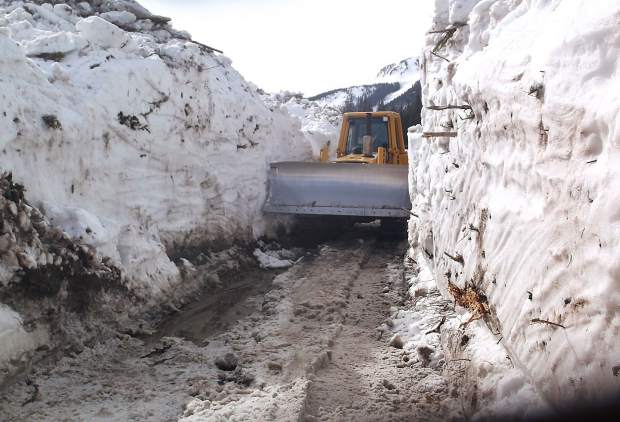
-
Glenn and Kim Schryver undertook an intense effort to plow through the snow on Lincoln Creek Road this winter. It took 13 days to bust through this year because of all the avalanche debris.
Schryver family/courtesy photo
-
Glenn Schryver’s bulldozer is dwarfed by the snowfield along Lincoln Creek Road. Bashing through tree trunks and boulders forced emergency repairs on the machine.
Schryver family/courtesy photo
-
An avalanche toppled numerous tree trunks and other debris where campsite No. 9 used to be along Lincoln Creek Road.
Schryver family/courtesy photo
-
Driving toward Green Mountain, where multiple slides roared into Lincoln Creek Valley as well as on the other side, in the Highway 82 corridor.
Schryver family/courtesy photo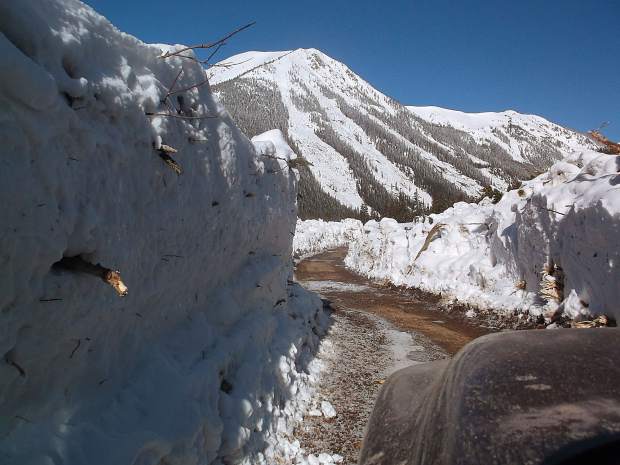
-
Aspen tree limbs downed by an avalanche protrude from the snowbank after the plowing of Lincoln Creek Road.
Schryver family/courtesy photo
-
The Schryver’s machinery is dwarfed by the snowfield while plowing Lincoln Creek Road.
Schryver family/courtesy photo
-
Tree trunks are stacked like matchsticks after the Schryvers plowed Lincoln Creek Road. They plowed through the debris of 14 avalanches.
Schryver family/courtesy photo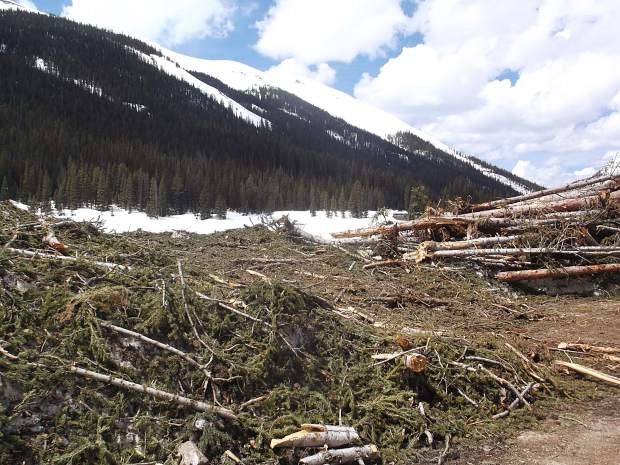
-
A front-end loader had to be used to remove this massive tree trunk from Lincoln Creek Road.
Schryver family/courtesy photo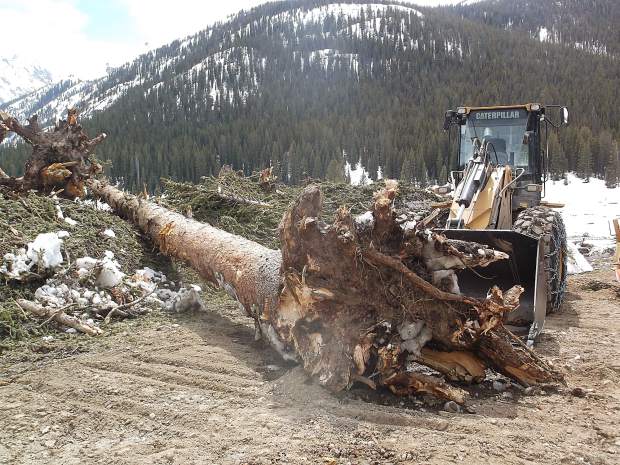
-
A dog walks the straight and narrow on freshly plowed Lincoln Creek Road.
Schryver family/courtesy photo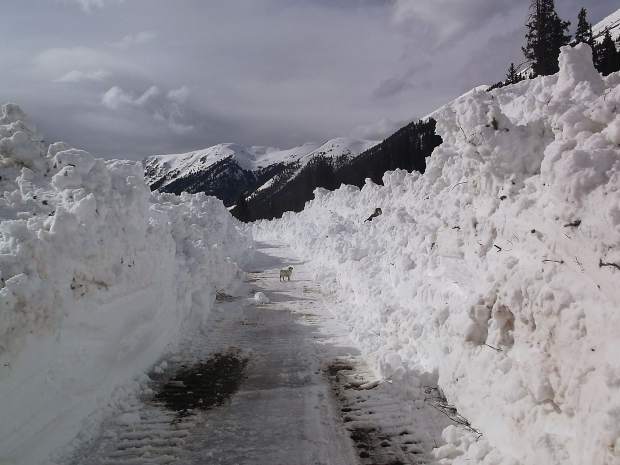
-
The Schrybers said they could see eight avalanches from their home in Grizzly Camp, about 17 miles southeast of Aspen. The slides were part of the historic avalanche cycle triggered after nearly six feet of snow fell the first week of March.
Schryver family/courtesy photo
Nobody in the Aspen area had a tougher winter battling the elements than Glenn and Kim Schryver, the year-round caretakers at Grizzly Reservoir.
Consider this:
• The Schryver’s were snowbound for 16 days.
• Avalanches caused minor damage to the water diversion facilities they oversee at the reservoir, roughly 17 miles southeast of Aspen.
“We plowed through 14 avalanches. I broke the dozer twice and had to weld things back together to finish.” — Glenn Schryver
• The closest slide deposited debris within 100 yards of their house.
• It took them 13 days to plow out 6 miles of Lincoln Creek Road from the reservoir to Highway 82. The job usually takes them three or four days.
Glenn said this was one of the most challenging winters they have faced in the 11 years he and Kim have been caretakers at what’s known as Grizzly Camp.
“I hope we don’t have another winter like this as long as I’m here,” he said.
Highway 82 is closed for the winter 6 miles east of Aspen. Lincoln Creek Road starts another 5 miles east of the winter closure gate, and the Schryver’s home is about 6 mile up Lincoln Creek, so there’s no way that route gets traveled in winters.
Instead, they drive through the 3.8-mile water diversion tunnel that bores underneath the Continental Divide and hooks into Highway 82 on the Twin Lakes side.
The route outside the tunnel was snowed shut during the first week of March, when the Schryvers recorded 71 inches of snowfall at Grizzly Reservoir.
“The highway over there (in Twin Lakes) was blocked by four avalanches,” Glenn said in an email interview with The Aspen Times. “So we were stuck here for 16 days. When we did try to get out, the east end of the tunnel was blocked by snow.”
The heavy snow resulted in an incredibly active avalanche cycle in their neck of the woods — which is surrounded by numerous jagged peaks topping 12,000 and 13,000 feet. On March 7, a slide pushed debris halfway across Grizzly Reservoir.
One of the biggest slides came during the night during a snowstorm. While they didn’t hear the actual slide, Kim recalled hearing the dogs whining outside and they couldn’t figure out why.
They had the bedroom window cracked open and realized the next morning that the avalanche blast had blown snow into the room.
“It was jaw dropping when we walked out the next morning,” Glenn said.
“On March 8, two more avalanches slid at the same time and came across our gate house, the building that controls the flows into the tunnel,” Schryver said.
The gate house is built like a World War II pillbox so it escaped damage inside, but the slide wiped out the exhaust from the generator and caused damage to the mechanism used to control water flow.
“We spent a couple of days digging out to the gate house so we could control the water flows,” Schryver said. The deep snow debris from the avalanches settled into concrete.
Slides off of Green Mountain, a majestic peak west of Independence ghost town, wreaked havoc in the Highway 82 corridor as well as Lincoln Creek drainage. It produced massive slides in both directions. In the highway corridor, it came roaring down the mountainside, covered the road and bowled over scores of aspen trees on the north side of Highway 82.
By late March, the Schryvers were able to resume travels through the tunnel to access Highway 82 on the Twin Lakes side. Their duties also required them to ride snowmobiles down from Grizzly to Lost Man Reservoir to take snow measurements. They saw more of Mother Nature’s raw power along Lincoln Creek, where several designated campsites are dispersed.
“There was a ton of damage down the canyon, mainly by campsite 7 but also campsites 5, 8, 9 and 11,” Schryver said. “The beautiful grove of aspens at the base of Green Mountain is totally gone. Most of the slides slid down the mountain and up the other side, knocking timber down on both sides.”
Each spring, the Schryvers plow out Lincoln Creek Road from the reservoir to Highway 82 so they can tend to the diversion system and because they cannot drive through the diversion tunnel when it is at full capacity. The plowing is a job that usually takes them three or four days, he said. It was a tough 13 days this April before they finally broke through to Highway 82.
“We plowed through 14 avalanches,” Schryver said. “I broke the dozer twice and had to weld things back together to finish.”
He estimated they plowed through hundreds of trees and rocks. The biggest tree trunk measured 120 inches at the base, clearly driving home the destructive force of the slides. A huge boulder was imbedded by campsite 7.
The biggest challenge was locating the road under deep, rock-hard snow. The trees and land features they were used to checking to keep their bearings while plowing were either buried or destroyed by the avalanches.
While the snowfall was above average, what really made the winter memorable was all the snow falling during the first week of March, Schryver said. All that snow loading on weak underlying layers resulted in huge slides not only near Grizzly Reservoir but in Maroon and Castle Creek Valleys, Marble and Conundrum Valley, where the granddaddy slide of them all occurred.
“It will be interesting to see what things look like when all the snow melts,” Schryver said of the Lincoln Creek Valley.
